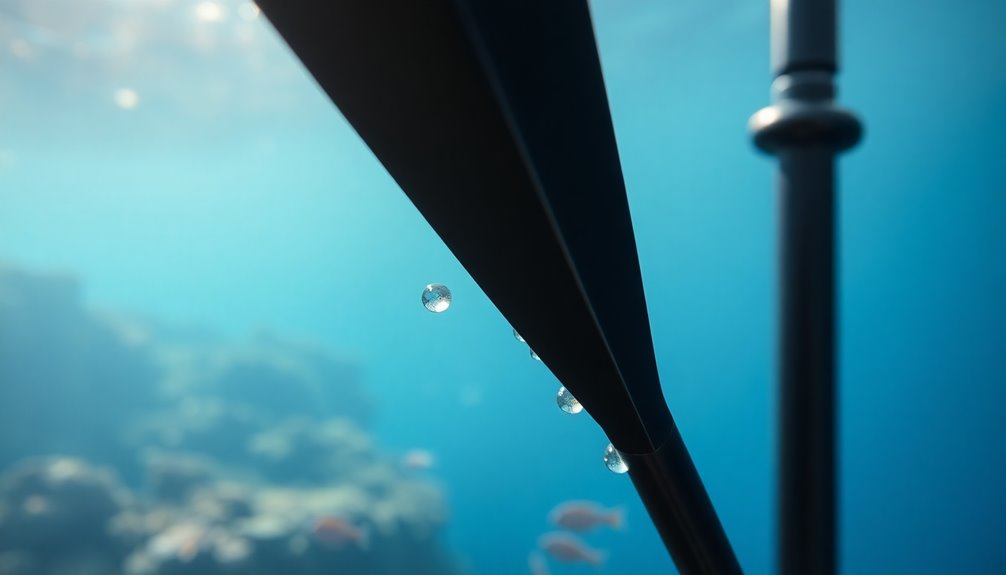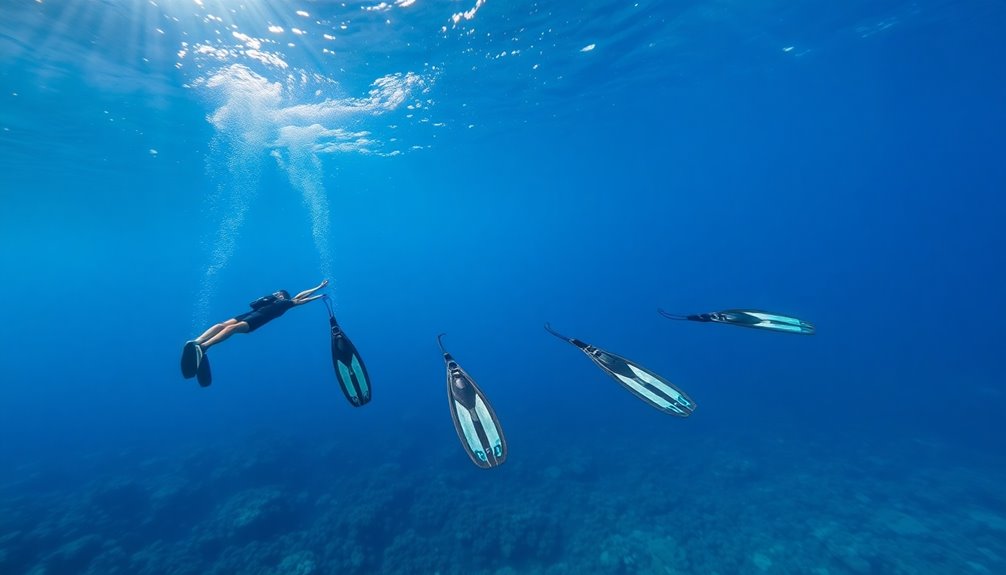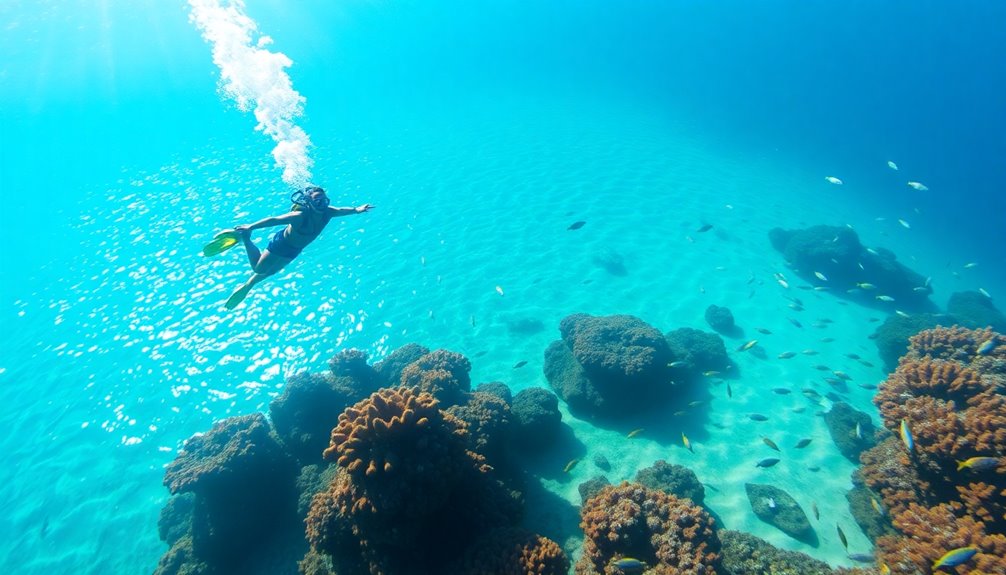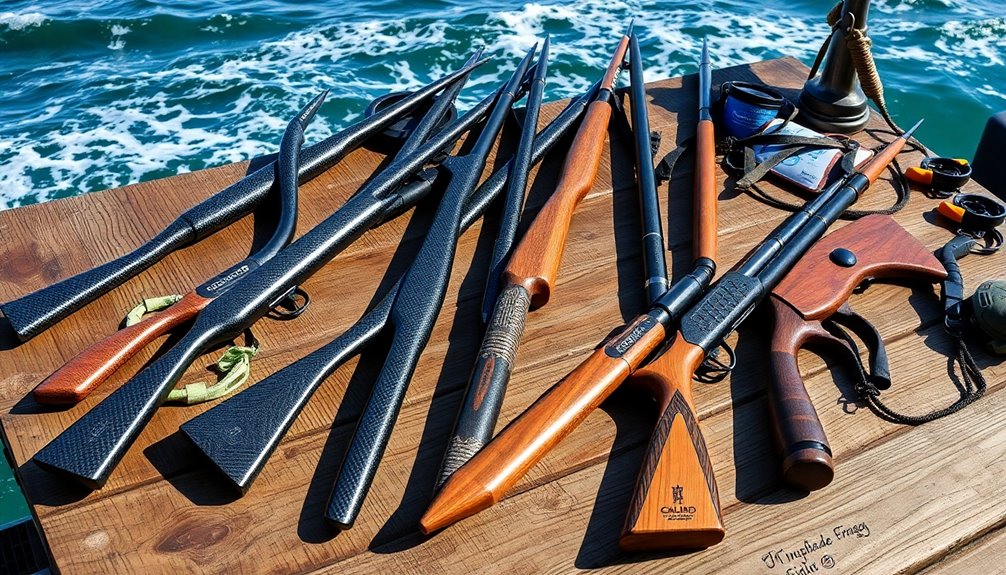A weight belt is essential for your diving adventures! It helps you maintain control, making it easier to float and swim smoothly underwater. With the right weight, you'll enjoy longer dives, feeling comfortable and safe. You can choose from different types, like rubber or nylon, depending on your needs. Properly distributing the weight means you won't tip or roll, adding to your fun. Plus, a great weight belt allows for quick releases in emergencies. Take care of it, and you'll have more amazing underwater experiences! Stick around to discover how a weight belt can transform your diving journey!
Key Takeaways
- Choose a suitable weight belt type, like rubber or silicone, for comfort and durability, enhancing your overall diving experience.
- Ensure proper weight distribution by balancing weights on both sides to maintain stability and prevent rolling underwater.
- Regularly inspect and maintain your weight belt to prevent wear and ensure safe, effective buoyancy control during dives.
- Adjust weights based on water type and personal comfort to achieve optimal buoyancy, allowing longer and more enjoyable dives.
- Utilize quick-release buckles for emergency situations, enhancing safety while enjoying the depths.
Importance of Weight Belts

When you dive, a weight belt is crucial for maintaining buoyancy control and ensuring your safety underwater. It helps you descend smoothly, stay at the right depth, and ascend safely. That balance is vital, especially when your tank gets empty. Proper weighting is essential to ensure you achieve neutral buoyancy, allowing you to enjoy the sights without worrying about your surroundings.
Safety is another big reason to wear a weight belt. If you ever face an emergency, you can quickly release the weights and float back to the surface. This prevents accidental floating away, keeping your dive safe and secure.
A properly fitted weight belt also helps you avoid accidents by keeping your buoyancy stable, even in changing water conditions. Comfort and efficiency are key too! With a weight belt, you can adjust your buoyancy to match your gear and body. This means less effort swimming and more time enjoying the underwater world.
You'll feel balanced and trim, making every dive a joyful experience. So, strap on that weight belt and dive in!
Types of Diving Weight Belts

Understanding the different types of diving weight belts can greatly enhance your underwater experience. There are three main types: webbing, rubber, and silicone.
Webbing belts are made of nylon and are the cheapest option. They're strong and last a long time, but they can be uncomfortable and don't stretch. You might find these belts in rental gear since they're affordable, but they don't stay in place very well. Freediving weight belts are designed to hold weights around the waist to counteract buoyancy, making them essential for effective diving.
Rubber weight belts, on the other hand, are super durable and will fit you comfortably, even when temperatures change. They stretch to your body, ensuring better comfort and keeping lead weights in place. Many freedivers and spearfishers prefer rubber belts for these reasons.
If you want the best, silicone weight belts are the way to go. They're a bit pricier but offer similar durability and comfort as rubber belts, with some extra perks.
Lastly, don't forget about buckles! Quick release buckles allow for easy removal, while Marseillaise buckles are a favorite among experienced divers. Choosing the right buckle matters, too, so you'll feel safe and secure while exploring the depths!
How to Choose the Right Belt
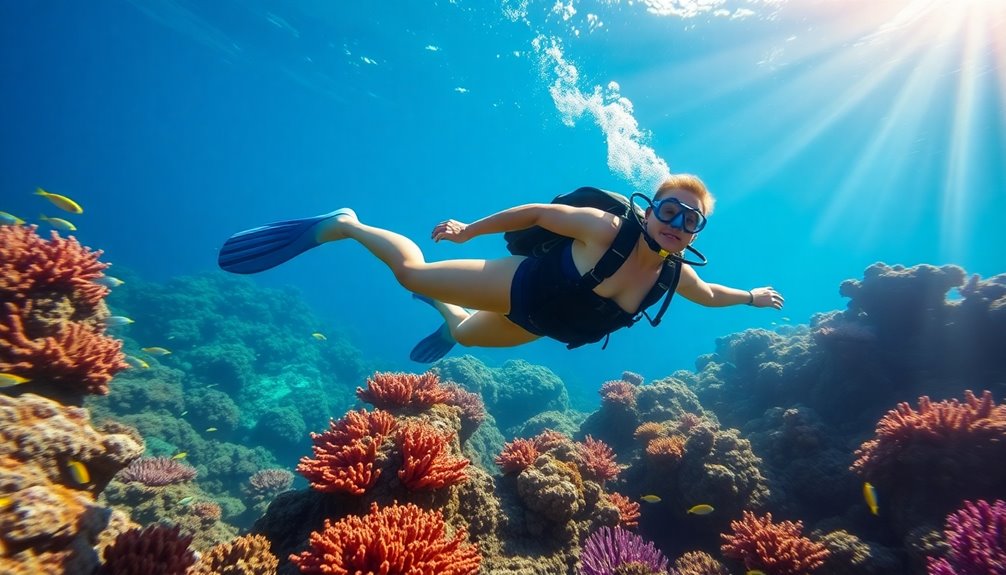
Choosing the right diving weight belt can make a significant difference in your underwater experience. First, measure around your hips to find a size that fits comfortably, neither too tight nor too loose.
Look for a belt with an adjustable buckle so it can fit different waist sizes and diving conditions. It's important to choose a belt made from comfortable, durable materials like nylon or rubber. Additionally, many belts feature quick-release buckles that enhance safety and convenience during dives.
Next, consider the type of water you'll be diving in. Saltwater requires more weight than freshwater because of its buoyancy.
Also, think about your wetsuit's thickness; thicker suits need more weight. When selecting a belt, pick one with a quick-release buckle for emergencies. This feature is essential for your safety!
Finally, make sure your belt can be adjusted easily to fit different gear configurations. Comfort and stability are key, so choose a belt that feels good while you dive.
Proper Weight Distribution Techniques
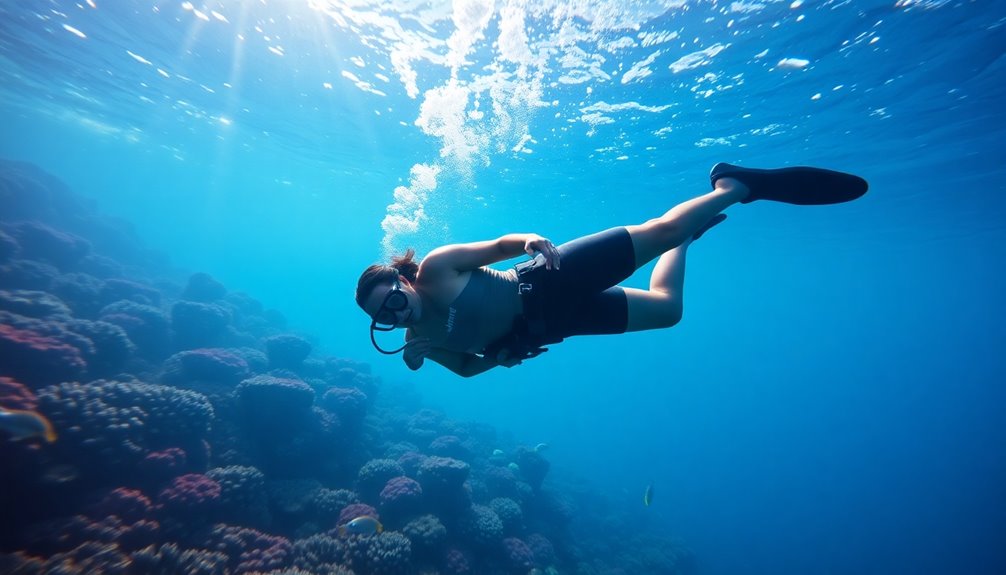
How can you ensure proper weight distribution while diving? It's all about balance!
Start by figuring out how much weight you need. For saltwater, that's about 10% of your body weight, and for freshwater, it's around 7%. If you're in cold water, add 4-6 pounds for a thicker suit. But if you're in warm water with a thin wetsuit, take away 4-6 pounds.
Next, it's important to place your weights correctly. You can use a weight belt, integrated pockets in your BCD, or even ankle weights. Make sure the weights are balanced on both sides to avoid tipping or rolling. Proper weight management impacts air consumption during dives, which is vital for a successful experience.
For dry suits, keep weights at your hips. If you're in a wetsuit, position them above your hips. This helps you stay horizontal in the water, making it easier to swim and reducing drag.
Don't forget to check your buoyancy! Before each dive, ensure you float at eye-level with a normal breath and deflated BCD. Adjust your weights as needed.
Dive conditions and your skills can change, so be flexible and keep experimenting until you find what feels just right! Happy diving!
Benefits of Using a Weight Belt
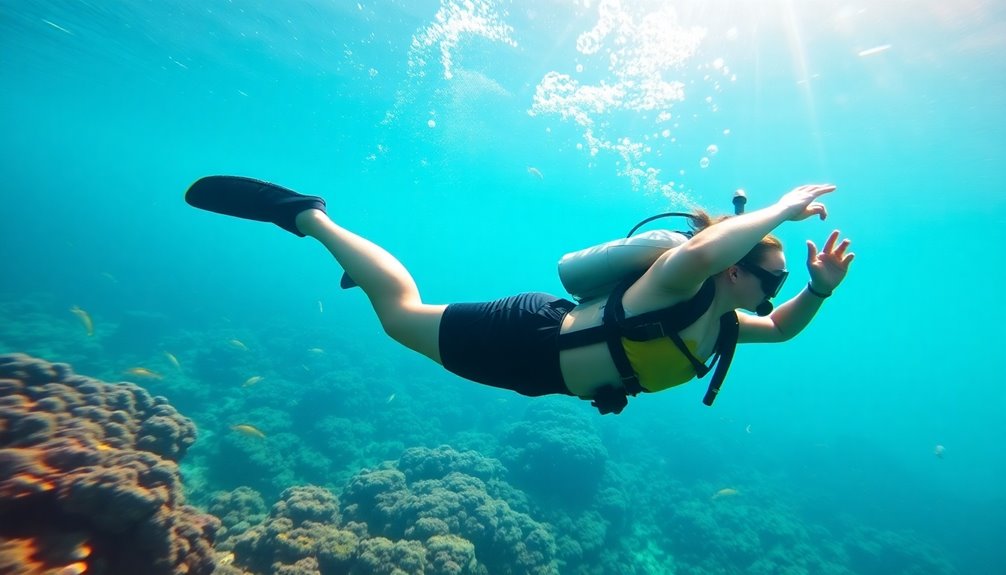
Proper weight distribution techniques set the foundation for effective buoyancy control, and using a weight belt enhances this experience significantly. With proper weight distribution and the use of a weight belt, divers can achieve perfect buoyancy, allowing them to effortlessly hover in the water without sinking or rising. This not only conserves energy but also minimizes the impact on the delicate marine environment. By mastering these techniques, divers can glide through the water with precision and grace, fully immersed in the beauty of the underwater world.
When you wear a weight belt, it helps you stay at just the right depth. You can be positively buoyant at the surface, allowing you to float easily, and then switch to negative buoyancy when diving deeper. This means less effort to plunge down, letting you enjoy the underwater world longer.
Using a weight belt also saves your energy. With better buoyancy, you won't have to kick as much, which is great for observing marine life without scaring them away. You'll find that you can dive longer, as you conserve energy and feel less tired. Additionally, balanced weight distribution on your hips with a weight belt is preferred to enhance comfort during dives.
Plus, a weight belt improves your diving technique. You can ascend and descend smoothly, keeping control of your depth. If you want to hover at a specific spot, the weight belt makes that easy.
Finally, weight belts are super versatile! You can adjust weights based on conditions or your gear. Whether you're in fresh or saltwater, a weight belt helps you fine-tune your buoyancy.
Get ready to dive in and explore with confidence!
Safety Considerations for Divers

Ensuring your safety while diving is crucial for an enjoyable experience beneath the waves. Before you dive, always check your equipment. Make sure your weight belt is snug and secure. A loose belt can lead to problems.
Inspect your regulator, BCD, and other gear for any damage, and ensure your dive computer or watch is working properly. Regularly inspect gear for wear and tear to prevent issues during the dive.
Planning your dive is equally important. Create a detailed plan, including how deep you'll go and how long you'll stay down. Keep an eye on your air supply to avoid running low.
Know the water conditions, like temperature and currents, and be ready for emergencies, like getting separated from your buddy.
Diving with a buddy is a must! Stay close and communicate clearly. Regularly check on each other's air supply and overall well-being. If something feels off, don't hesitate to abort the dive.
Finally, be sure you're physically and mentally ready. Get plenty of rest, stay hydrated, and avoid alcohol and caffeine.
If you're feeling uneasy about the conditions, it's best to wait for another day. Safety first ensures you'll love every moment underwater!
Maintenance and Care Tips
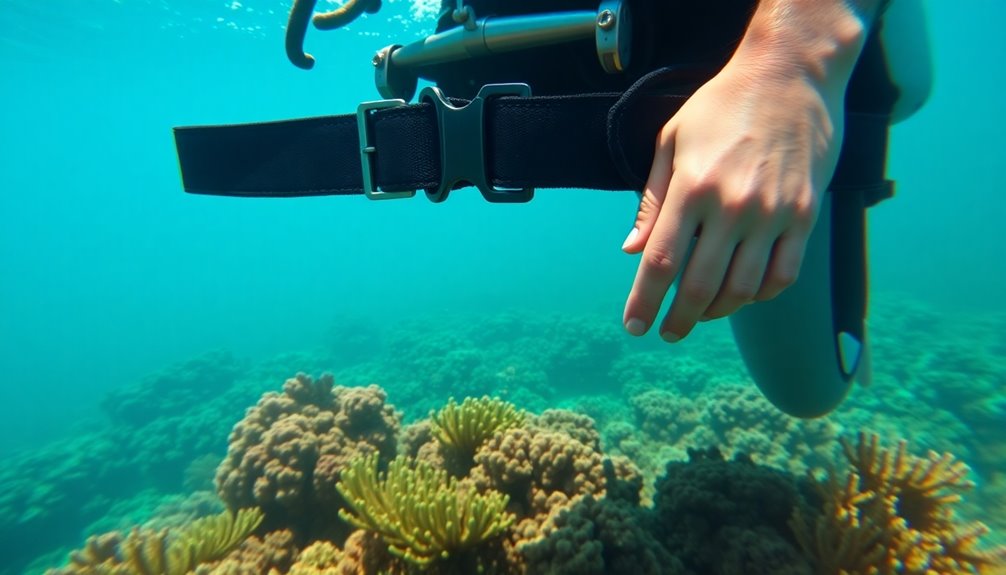
Caring for your weight belt is essential for its longevity and your diving safety. After each dive, rinse it with fresh water to wash away salt and debris. You can use a hose or shower for this, making sure to clean any valves and buttons too.
Don't forget to inspect your weight belt regularly. Look for signs of wear, like fraying webbing or damaged buckles. Ensure the weights are securely attached and free from defects.
When you're not diving, store your weight belt in a cool, dry place, away from direct sunlight. It's best to avoid leaving weights on the belt when not in use. Additionally, remember that regular inspection can help identify issues before they become serious problems.
Dry all your dive gear thoroughly before storing it. Hang your wetsuit and BCD in a well-ventilated area to keep them fresh.
Make it a habit to get your dive gear serviced every year or after every 100 dives. This includes a check-up for cracks, tears, or rust.
And remember, inspect your gear every couple of months, especially if it's not used often. With proper care, your weight belt will serve you well in many underwater adventures!
Enhancing Your Diving Experience
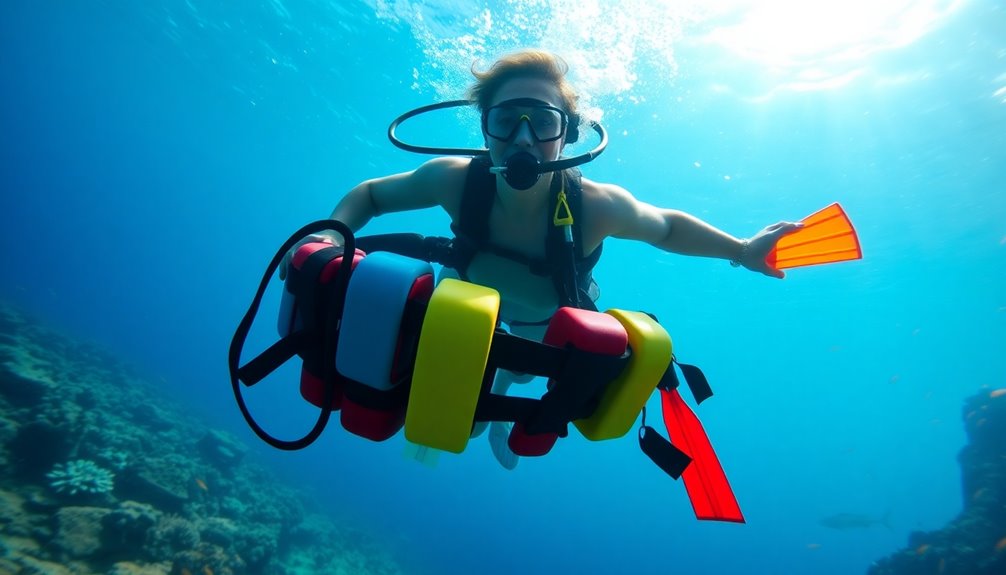
Enhancing your diving experience is all about achieving the right balance between comfort, safety, and buoyancy control. When you wear a weight belt, it helps you float just right.
For freedivers, placing weights close to your center of buoyancy is key. Make sure to perform buoyancy checks at the surface. You should float at the neck-shoulder level with a full breath.
Using the right type of weight matters too! Lace-through weights stay in place, while bullet weights let you adjust easily. Remember, having quick-release mechanisms is important for emergencies. They can help you ascend quickly if needed. Proper weight selection is crucial for maintaining buoyancy control and ensuring a safe dive experience.
Proper weighting reduces your diving effort. When you find that sweet spot, you can stay at depth longer without tiring out. This makes diving more enjoyable!
And don't forget to adjust your weight based on your gear and the water you're diving in.
With balanced weight, you can feel safe and comfortable underwater. A well-fitted weight belt or integrated system can make all the difference.
Frequently Asked Questions
Can I Use a Weight Belt for Snorkeling?
Yes, you can use a weight belt for snorkeling! It helps you dive deeper with less effort and stay underwater longer.
Just remember, it's important to adjust the weight carefully to stay buoyant. If you're new to snorkeling, it's best to practice without a belt first.
Once you're comfortable, a weight belt can make exploring underwater even more fun! Enjoy the colorful fish and beautiful sights below the surface!
How Do I Know How Much Weight to Use?
To figure out how much weight you need, start with your body weight. Use around 10% for cold salt water and 5% for warm.
If you're wearing a wetsuit, thicker suits need more weight. Don't forget to adjust for fresh water, which requires less weight.
Always check your buoyancy: float at eye level with gear on, then try descending with an empty BCD. Adjust until you feel just right!
Are Weight Belts Suitable for All Diving Conditions?
Weight belts aren't one-size-fits-all for diving. They need to match the type of diving you're doing!
For scuba diving, you'll need more weight to balance your gear. In free diving, less weight is usually better.
Also, pay attention to your wetsuit or drysuit thickness. Each dive has unique conditions, so make sure to adjust your weight belt accordingly.
Staying safe and comfortable is the key to enjoying your underwater adventures!
Can I Make My Own Weight Belt?
Absolutely, you can make your own weight belt!
Start by gathering some lead shot and strong fabric, like duck canvas. You'll need a sewing machine, too.
First, measure the lead shot and bag it up. Then, cut and sew the fabric into pouches. Fill those pouches with the shot and seal them tight.
Finally, label each pouch with its weight. It's a fun project that lets you customize your diving experience!
What Materials Are Best for Weight Belt Construction?
When choosing materials for a weight belt, you've got some great options!
Rubber belts are super durable and comfy, making them perfect for deeper dives.
Silicone belts are soft and eco-friendly, plus they reduce drag in the water.
If you're on a budget, nylon webbing is lightweight and affordable, but it mightn't fit as snugly.
Each material has its perks, so think about what works best for your diving adventures!
Conclusion
Using a weight belt can truly change your diving adventures! It helps you stay balanced and enjoy the beautiful underwater world longer. Remember to choose the right belt for you and learn proper weight distribution techniques. Safety is key, so always check your gear. With a little care and maintenance, you'll be ready for amazing dives. So, dive in, explore, and make wonderful memories beneath the waves! Happy diving, and enjoy every moment in the depths!


